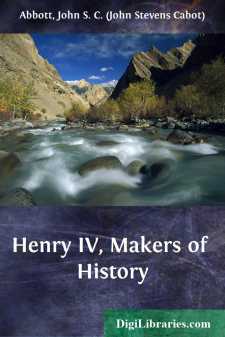Categories
- Antiques & Collectibles 13
- Architecture 36
- Art 48
- Bibles 22
- Biography & Autobiography 813
- Body, Mind & Spirit 142
- Business & Economics 28
- Children's Books 17
- Children's Fiction 14
- Computers 4
- Cooking 94
- Crafts & Hobbies 4
- Drama 346
- Education 46
- Family & Relationships 57
- Fiction 11829
- Games 19
- Gardening 17
- Health & Fitness 34
- History 1377
- House & Home 1
- Humor 147
- Juvenile Fiction 1873
- Juvenile Nonfiction 202
- Language Arts & Disciplines 88
- Law 16
- Literary Collections 686
- Literary Criticism 179
- Mathematics 13
- Medical 41
- Music 40
- Nature 179
- Non-Classifiable 1768
- Performing Arts 7
- Periodicals 1453
- Philosophy 64
- Photography 2
- Poetry 896
- Political Science 203
- Psychology 42
- Reference 154
- Religion 513
- Science 126
- Self-Help 84
- Social Science 81
- Sports & Recreation 34
- Study Aids 3
- Technology & Engineering 59
- Transportation 23
- Travel 463
- True Crime 29
John S. C. (John Stevens Cabot) Abbott
John Stevens Cabot Abbott (1805-1877) was an American historian, pastor, and pedagogical writer. He is best known for his works on Napoleon Bonaparte, including "The History of Napoleon Bonaparte," which was a popular biography in the 19th century. Abbott also authored numerous other historical books, many of which focused on notable figures and events from American and European history.
Author's Books:
Sort by:
PREFACE. Next to George Washington, we must write, upon the Catalogue of American Patriots, the name of Benjamin Franklin. He had so many virtues that there is no need of exaggerating them; so few imperfections that they need not be concealed. The writer has endeavored to give a perfectly accurate view of his character, and of that great struggle, in which he took so conspicuous a part, which secured...
more...
CHAPTER I. Early Training. Birth of Christopher Carson.—Perils of the Wilderness.—Necessary Cautions.—Romance of the Forest.—The Far West.—The Encampment.—The Cabin and the Fort.—Kit an Apprentice.—The Alarm.—Destruction of a Trading Band.—The Battle and the Flight.—Sufferings of the Fugitives.—Dreadful Fate of Mr. Schenck.—Features of the Western Wilderness.—The March....
more...
CHAPTER I. The Discovery and early Settlement of America. Discovery of the New World.—Of Florida.—Conquest and cruelties of De Soto.—The wigwam.—Colony at St. Mary.—Sir Walter Raleigh and his Colonies.—Grant of King James.—Settlements in the Virginia.—Adventures of John Smith.—Arrival of Lord Delaware.—Terrible massacres.—Pressures of Colonists to the West.—Doherty Trade with...
more...
A little more than a hundred years ago, a poor man, by the name of Crockett, embarked on board an emigrant-ship, in Ireland, for the New World. He was in the humblest station in life. But very little is known respecting his uneventful career excepting its tragical close. His family consisted of a wife and three or four children. Just before he sailed, or on the Atlantic passage, a son was born, to whom...
more...
Mr. Theodore Irving, in his valuable history of the "Conquest of Florida," speaking of the astonishing achievements of the Spanish Cavaliers, in the dawn of the sixteenth century says: "Of all the enterprises undertaken in this spirit of daring adventure, none has surpassed, for hardihood and variety of incident, that of the renowned Hernando de Soto, and his band of cavaliers. It was...
more...
Chapter I. Childhood and Youth. 1475-1564Navarre.Catharine de Foix.About four hundred years ago there was a small kingdom, spreading over the cliffs and ravines of the eastern extremity of the Pyrenees, called Navarre. Its population, of about five hundred thousand, consisted of a very simple, frugal, and industrious people. Those who lived upon the shore washed by the stormy waves of the Bay of Biscay...
more...
Chapter I. The Discovery of Mexico.The shore of America in 1492.Three hundred and fifty years ago the ocean which washes the shores of America was one vast and silent solitude. No ship plowed its waves; no sail whitened its surface. On the 11th of October, 1492, three small vessels might have been seen invading, for the first time, these hitherto unknown waters. They were as specks on the bosom of...
more...
Chapter I. 1776-1794Josephine's voyage to France.In the year 1776 a very beautiful young lady, by the name of Josephine Rose Tascher, was crossing the Atlantic Ocean from the island of Martinique to France. She was but fifteen years of age; and, having been left an orphan in infancy, had been tenderly reared by an uncle and aunt, who were wealthy, being proprietors of one of the finest plantations...
more...
Chapter I. Life in Martinique. A.D. 1760-A.D. 1775Martinique.Its varied beauties.The island of Martinique emerges in tropical luxuriance from the bosom of the Caribbean Sea. A meridian sun causes the whole land to smile in perennial verdure, and all the gorgeous flowers and luscious fruits of the torrid zone adorn upland and prairie in boundless profusion. Mountains, densely wooded, rear their summits...
more...
Chapter I. Landing of the Pilgrims. 1620-1621Arrival of the Mayflower.On the 11th of November, 1620, the storm-battered Mayflower, with its band of one hundred and one Pilgrims, first caught sight of the barren sand-hills of Cape Cod. The shore presented a cheerless scene even for those weary of a more than four months voyage upon a cold and tempestuous sea. But, dismal as the prospect was, after...
more...











